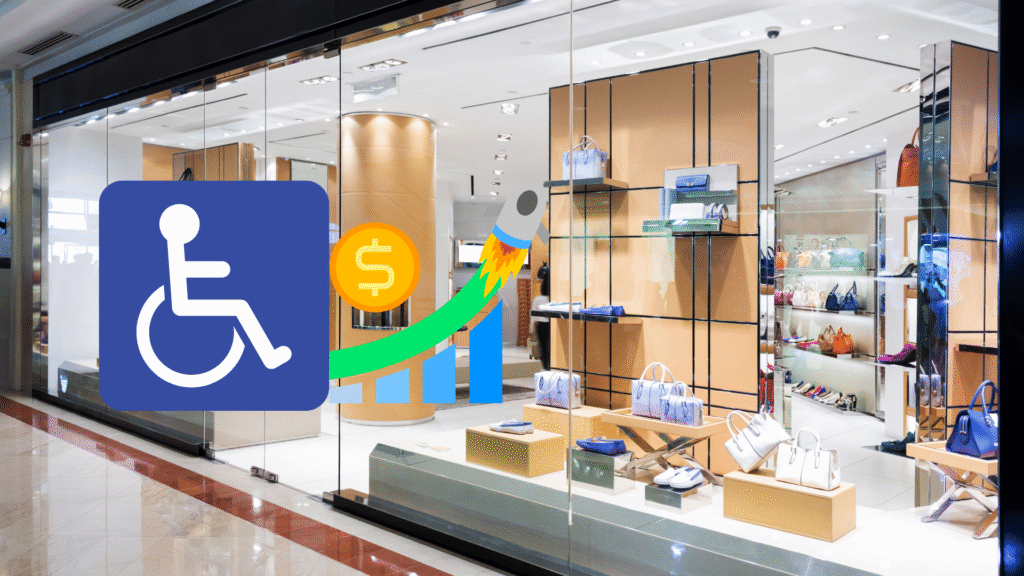Why Accessibility Matters in Retail Today
Retail is evolving, and so are customer expectations. Shoppers aren’t just looking for trendy products or good prices—they’re also looking for inclusive, welcoming environments.
For Australians with disabilities, visiting a shop or mall can still be a frustrating experience. Many retail spaces lack ramps, accessible change rooms, or proper signage. Others are physically difficult to navigate, especially for people using wheelchairs, mobility scooters, or walking aids.
This isn’t just a social issue, it’s also a missed business opportunity.
The Connection Between Access and Sales
Accessibility directly impacts foot traffic, dwell time, and conversion rates. When your store is easy to navigate, more people can enter, stay longer, and buy with confidence.
Consider this:
- There are over 4.4 million Australians living with a disability. That’s nearly 1 in 5 customers.
- When a store is inaccessible, shoppers may choose competitors who prioritise their needs.
- Families and carers often shop together, meaning one inaccessible experience affects multiple potential buyers.
The business case is clear: the more accessible your space, the larger your customer base.
How Inclusive Design Builds Customer Loyalty
Accessibility improvements don’t just bring in new customers—they also encourage repeat business.
Features such as automatic doors, wide aisles, and seated service counters show customers you value their comfort and autonomy. These seemingly small upgrades often lead to stronger emotional connections and lasting brand trust.
When people feel respected and accommodated, they are far more likely to return and recommend your store to others.
Accessibility also promotes equity. Older adults, parents with prams, and people with temporary injuries all benefit from inclusive design—further expanding your reach.
Real-World Examples and Case Studies
Across Australia, shopping centres and retail brands are seeing the benefits of prioritising accessibility.
- Westfield Shopping Centres have rolled out inclusive features like quiet rooms, accessible bathrooms, and clearly marked mobility parking.
- Kmart and Target have received praise for wide pathways and improved shelf access in select locations.
- Local boutiques that invest in simple fixes—like portable ramps or better lighting—report an increase in customer satisfaction and positive reviews.
These changes don’t just help shoppers; they reflect forward-thinking business strategies.
How to Start Making Your Store More Accessible
You don’t need a massive budget to start improving accessibility. Begin with the basics:
- Clear pathways: Make sure aisles and entryways can accommodate wheelchairs or scooters.
- Accessible signage: Use large fonts, high contrast, and clear symbols.
- Seating areas: Provide rest stops for elderly or disabled shoppers.
- Training staff: Educate your team on inclusive customer service practices.
You can also partner with accessibility consultants to audit your space or access grants that support disability-friendly upgrades.
At Assistive Tech Hub, we support retailers with expert advice and practical tools. Our range of assistive technologies can help stores become more welcoming and functional for everyone.
Whether you’re running a small boutique or managing a large shopping centre, we can help you meet both ethical and business goals.
Where to Go From Here
Accessibility is more than a checklist. It’s a long-term investment in your brand’s future.
By making retail spaces easier to access, you’re not just following regulations—you’re building trust, growing your audience, and increasing revenue.
Ready to take the next step?
FAQs
Why should I prioritise accessibility in my retail store?
Because it expands your customer base, improves customer experience, and increases loyalty. Inclusive design supports ethical business practices and makes financial sense.
What are the most impactful upgrades I can start with?
Widening aisles, installing ramps, adding automatic doors, improving lighting, and training staff on inclusive service are excellent first steps.
How can I check if my store meets accessibility standards?
You can conduct an internal review using accessibility checklists, or work with professionals for a detailed audit.
Is it expensive to make a store accessible?
Many basic changes are affordable and cost-effective. The ROI often comes from increased foot traffic and repeat business.
Where can I get help or advice?
You can contact Assistive Tech Hub for support, product recommendations, and expert consultation.
Let’s Build Inclusive Retail Together
Don’t let accessibility be an afterthought. Make it part of your brand’s identity.
Explore our assistive technologies for shopping centres, or reach out to our team for tailored guidance.
Lead the way in inclusive retail, and join the movement now!



